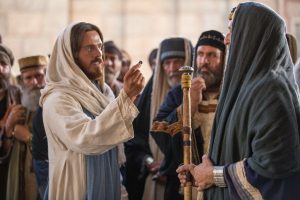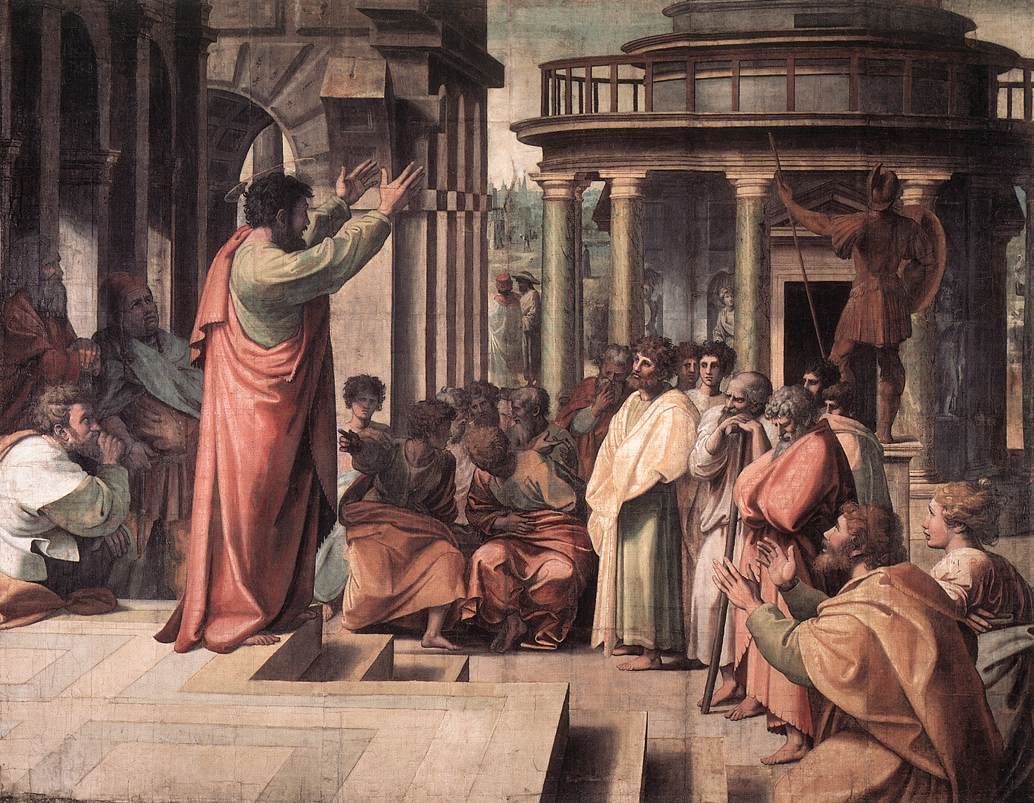Whether it’s Paul’s address to the Athenians in Acts 17 or Jesus’ refusal to answer the Pharisees’ questions about his authority in Matthew 21, many of the most powerful interactions and addresses of scripture are rhetorically structured. Understanding that structure can help us to better understand the whole context of an argument, as well as its most relevant points.
 Some rhetorical structures are as simple as a question challenged by a question, the answer being based on the original questioner’s response. Such rhetorical interactions are often a contest of wits, played out in public according to rules familiar to the original audience. For example, When the Pharisees asked Jesus by what authority he taught (Matt 21:23), Jesus responded with a question of his own. The Pharisees’ refusal to answer His question was then used to justify Jesus’ refusal to answer their original question. The same structure can be seen in the next chapter when the Pharisees and Herodians try to trap Jesus in a lose-lose question about the lawfulness of paying taxes. Understanding that such questions are not information-seeking interactions but are instead a rhetorical dance played out for others — whether the crowd or the Crown — can help us to better interpret the Word as recorded for us.
Some rhetorical structures are as simple as a question challenged by a question, the answer being based on the original questioner’s response. Such rhetorical interactions are often a contest of wits, played out in public according to rules familiar to the original audience. For example, When the Pharisees asked Jesus by what authority he taught (Matt 21:23), Jesus responded with a question of his own. The Pharisees’ refusal to answer His question was then used to justify Jesus’ refusal to answer their original question. The same structure can be seen in the next chapter when the Pharisees and Herodians try to trap Jesus in a lose-lose question about the lawfulness of paying taxes. Understanding that such questions are not information-seeking interactions but are instead a rhetorical dance played out for others — whether the crowd or the Crown — can help us to better interpret the Word as recorded for us.
Other rhetorical structures are far more complicated, following rules both formal and informal, and attacking and defending on different levels at the same time. In First Corinthians 15, Paul uses interrogation, irony, witness testimony, history, and the authority of church doctrine to illustrate that not only was Christ raised from the dead, but that His resurrection is the central fact of the Christian faith. But Paul doesn’t just throw his assertions at the Corinthians willy-nilly. His arguments are based in a Greco-Roman rhetorical style that gives the overall passage a compelling persuasive power. That’s what good rhetoric does.
So here is Paul’s argument for the resurrection from the dead, interspersed with descriptions of each rhetorical section – both purpose and contents – followed by an outline of the scripture itself. I hope that reading Scriptures’ most complete teaching on the meaning and importance of the Resurrection within its native rhetorical structure gives you additional insight into both our Savior and our faith.
Exordium* (vv1-2) – An introduction in which the writer sets forth his concerns and intentions. The exordium introduced planned, recurring themes like Paul’s phrase “in vain,” repeated throughout the argument (vv. 10, 14, 17, 58) and thematically explored in verses 12-19 and 29-34.
Now I make known to you, brethren, the Gospel
- which I preached to you,
- which you also received,
- in which you also said you stand,
- by which you are saved,
- if you hold fast the word which I preached to you,
- unless you have believed in vain.
Narratio (vv3-5) – Background information is provided. A narratio included judgments such as common sayings, popular beliefs, or supporting historical narrative. Verses 3b-5 represented the creed or “popular belief” of the church: Christ died, was buried, and was resurrected.
For I delivered to you as of first importance what I also received:
- that Christ died for our sins
- according to the scriptures, and
- that he was buried, and
- that he was raised on the third day
- according to the scriptures, and
- that he appeared
- to Peter, then
- to the Twelve. After that he appeared
- to more than five hundred brethren at one time,
- most of whom remain until now, but
- some have fallen asleep. Then he appeared
- to James, then
- to all the Apostles, and last of all, as to one untimely born, he appeared
- to me also. For I
- am the least of the apostles, and
- am not fit to be called an apostle, because
- I persecuted the church of God.
- But by the grace of God I am what I am,
- and his grace toward me did not prove in vain, but
- I have labored even more than all of them, yet
- not I, but the grace of God in me.
Whether it was I or they, so we preached and so you believed.
Refutatio (vv12-19) – The “proof” of the argument, typically begun with the claim of the opposition (here, that there is no resurrection [v. 12]). The refutatio then denied the asserted fact. Paul denied the “no resurrection” teaching by arguing that resurrection exemplified the Christian hope.
Now if Christ is preached that he has been raised from the dead, how do some of you say there is no resurrection of the dead?
- For if there is no resurrection of the dead,
- not even Christ has been raised.
- And if Christ has not been raised, then
- our preaching is in vain.
- Your faith is also in vain. Moreover,
- we are found to be false witnesses of God, because
- we testified against God that he raised Christ,
- whom he did not raise
- if in fact the dead are not raised.
- we testified against God that he raised Christ,
- For if the dead have not been raised and if Christ has not been raised,
- your faith is worthless;
- you are still in your sins. Then
- those who have fallen asleep in Christ have perished.
If we have hope in Christ in this life only, we are of all men most to be pitied.
Probatio (vv20-28) – This section consisted of a propositio, a statement of the proposition to be proven (v. 20); a ratio, or reason establishing the truth of the proposition (vv. 21-2, the historical examples of Adam and Christ); a central confirmatio which further proved the ratio, expressing it in a different way (vv. 23-4), and an exornatio, which confirmed the arguments presented (vv. 25-8).
 But now Christ has been raised from the dead, the first fruits of those who are asleep. For
But now Christ has been raised from the dead, the first fruits of those who are asleep. For
- since by one man came death, by a man also came resurrection of the dead. For
- as in Adam all die, so in Christ all will be made alive. But each in his own order:
- Christ the first fruits, after that
- those who are Christ’s at his coming,
- then comes the end, when he hands over the kingdom to the God and father,
- then he has abolished all rule and all authority and power.
- For he must reign until he has put all enemies under his feet.
- The last enemy that will be abolished is death. For
- “He has put all things in subjection under his feet” (but when he says all things are put in subjection, it is evident that He is excepted who put all things in subjection to him).
- When all things are subjected to him, then
- the son himself will also be subjected to the one who subjected all things to him, so that
- God may be all in all.
- When all things are subjected to him, then
Peroratio (vv29-34) – This section recapitulated the main points of the probatio and turned the case against the opposition by attacking their primary points. Paul used three strategies for composing a peroratio: interrogation (vv. 29-32a), irony (v. 32b), and proposal of policy (vv. 33-4).
Otherwise,
- what will those do who are baptized for the dead?
- If the dead are not raised at all, why are they baptized for them?
- Why are we also in danger every hour?
- I affirm, brethren, by the boasting in you which I have in Christ Jesus our Lord, I die daily.
- If from human motives I fought with wild beasts at Ephesus, what does it profit me?
- For if the dead are not raised,
- “Let us eat and drink, for tomorrow we die.”
- Do not be deceived:
- “bad company corrupts good morals.”
- Become sober-minded as you ought, and
- stop sinning: for some have no knowledge of God.
I speak this to your shame.
* Descriptions of the portions of Deliberative Rhetoric blatantly stolen from JP Holding of Tektonics.org.










4.5
5
“Descriptions of the portions of Deliberative Rhetoric blatantly stolen from JP Holding of Tektonics.org.”
Big fan of his work. Apologetics with a scholarly bent. Website has a large number of articles addressing common questions/criticisms of passages in the Bible.
Such as, did Jephthah sacrifice his daughter as a burnt offering in Judges?
http://www.tektonics.org/gk/jepthah.php
He’s really good. And I’m actually I glad I stole those snippets a few years ago, as they seem to have disappeared from his site, or at least my link was dead. IIRC, his original article had to do with the Mormon argument of “baptism for the dead” in verse 29, but as always he covered a lot more territory and did it well.